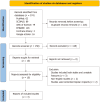Comparative efficacy of cementless bipolar hemiarthroplasty and proximal femoral nail anti-rotation in unstable intertrochanteric fractures: A meta-analysis
- PMID: 40698275
- PMCID: PMC12278281
- DOI: 10.5312/wjo.v16.i7.107950
Comparative efficacy of cementless bipolar hemiarthroplasty and proximal femoral nail anti-rotation in unstable intertrochanteric fractures: A meta-analysis
Abstract
Background: Unstable intertrochanteric fractures in elderly patients require effective surgical management, with both cementless bipolar hemiarthroplasty (CBHA) and proximal femoral nail anti-rotation (PFNA) being valid treatment options to reduce morbidity and mortality.
Aim: To evaluate and compare the outcomes of CBHA and PFNA in treatment of unstable intertrochanteric fractures.
Methods: A comprehensive search was conducted to identify relevant studies discussing the outcomes of using both CBH and PFNA in treatment of unstable intertrochanteric fractures. Studies published up to January 1, 2025 were searched across multiple databases, including PubMed, EMBASE, Scopus, Web of Science, Cochrane Library, and Google Scholar. Full texts of the selected articles were retrieved, reviewed, and independently assessed by the investigators. Discrepancies were resolved by consensus, with any remaining disagreements being arbitrated by a third author.
Results: This meta-analysis included three studies, all of which were retrospective, involving a total of 240 patients. The follow-up period for participants was at least 12 months. CBHA was associated with significantly higher blood loss compared to PFNA [mean differences (MD): 129.14, 95%CI (52.51, 205.77), P = 0.001], though heterogeneity was high (I² = 97%). Operative time showed no significant difference initially [MD: 6.10, 95%CI (-13.34, 25.54), P = 0.54], but after excluding one study, BHA had longer operative times [MD: 21.51, 95%CI (18.60, 24.41), P < 0.00001]. Hospital stay and Harris scores showed no significant differences between groups. CBHA facilitated faster progression to weight-bearing [MD: -11.92, 95%CI (-22.46, -1.39), P = 0.03] and a lower incidence of prosthetic loosening [risk ratio: 0.21, 95%CI (0.05, 0.92), P = 0.04]. Refracture and thrombus formation rates were comparable between the two groups.
Conclusion: CBHA offers shorter weight-bearing duration and reduced prosthetic loosening but incurs greater blood loss and longer operative times compared to PFNA. Both techniques show comparable functional recovery, hospital stay, refracture, and thrombus risks. Clinical choice should prioritize early mobilization or surgical minimalism, guided by patient needs. Further prospective studies are warranted.
Keywords: Cementless bipolar hemiarthroplasty; FFNA; Meta-analysis; Proximal femoral nail anti-rotation; Unstable intertrochanteric fractures; Unstable, Functional outcomes.
©The Author(s) 2025. Published by Baishideng Publishing Group Inc. All rights reserved.
Conflict of interest statement
Conflict-of-interest statement: All authors declare that they have no conflict of interest to disclose.
Figures




Similar articles
-
Surgical interventions for treating extracapsular hip fractures in older adults: a network meta-analysis.Cochrane Database Syst Rev. 2022 Feb 10;2(2):CD013405. doi: 10.1002/14651858.CD013405.pub2. Cochrane Database Syst Rev. 2022. PMID: 35142366 Free PMC article.
-
Fracture fixation versus hemiarthroplasty for unstable intertrochanteric fractures in elderly patients: A systematic review and network meta-analysis of randomized controlled trials.Orthop Traumatol Surg Res. 2022 Feb;108(1):102838. doi: 10.1016/j.otsr.2021.102838. Epub 2021 Jan 30. Orthop Traumatol Surg Res. 2022. PMID: 33529729
-
The clinical efficacy of proximal femoral nail antirotation and proximal femoral bionic nail in the treatment of intertrochanteric fractures of the femur in the elderly: A systematic review and meta-analysis.Jt Dis Relat Surg. 2025 Jul 21;36(3):522-534. doi: 10.52312/jdrs.2025.2302. Epub 2025 Jul 21. Jt Dis Relat Surg. 2025. PMID: 40783984
-
Nailing the Outcome: A Comparative Study of Proximal Femoral Nail Anti-Rotation-II and Trochanteric Fixation Nail in Unstable Intertrochanteric Femur Fractures.J Orthop Case Rep. 2025 Aug;15(8):312-317. doi: 10.13107/jocr.2025.v15.i08.5980. J Orthop Case Rep. 2025. PMID: 40786811 Free PMC article.
-
Surgical approaches for inserting hemiarthroplasty of the hip in people with hip fractures.Cochrane Database Syst Rev. 2025 Jun 13;6(6):CD016031. doi: 10.1002/14651858.CD016031. Cochrane Database Syst Rev. 2025. PMID: 40511667 Review.
References
-
- Lindskog DM, Baumgaertner MR. Unstable intertrochanteric hip fractures in the elderly. J Am Acad Orthop Surg. 2004;12:179–190. - PubMed
-
- Grisso JA, Kelsey JL, Strom BL, Chiu GY, Maislin G, O'Brien LA, Hoffman S, Kaplan F. Risk factors for falls as a cause of hip fracture in women. The Northeast Hip Fracture Study Group. N Engl J Med. 1991;324:1326–1331. - PubMed
-
- Sniderman J, Vivekanantha P, Shah A, Safir O, Wolfstadt J, Kuzyk P. Hemiarthroplasty for Unstable Intertrochanteric Hip Fractures: A Matched Cohort Study. J Arthroplasty. 2023;38:1522–1527. - PubMed
-
- Hongku N, Woratanarat P, Nitiwarangkul L, Rattanasiri S, Thakkinstian A. Fracture fixation versus hemiarthroplasty for unstable intertrochanteric fractures in elderly patients: A systematic review and network meta-analysis of randomized controlled trials. Orthop Traumatol Surg Res. 2022;108:102838. - PubMed
LinkOut - more resources
Full Text Sources

